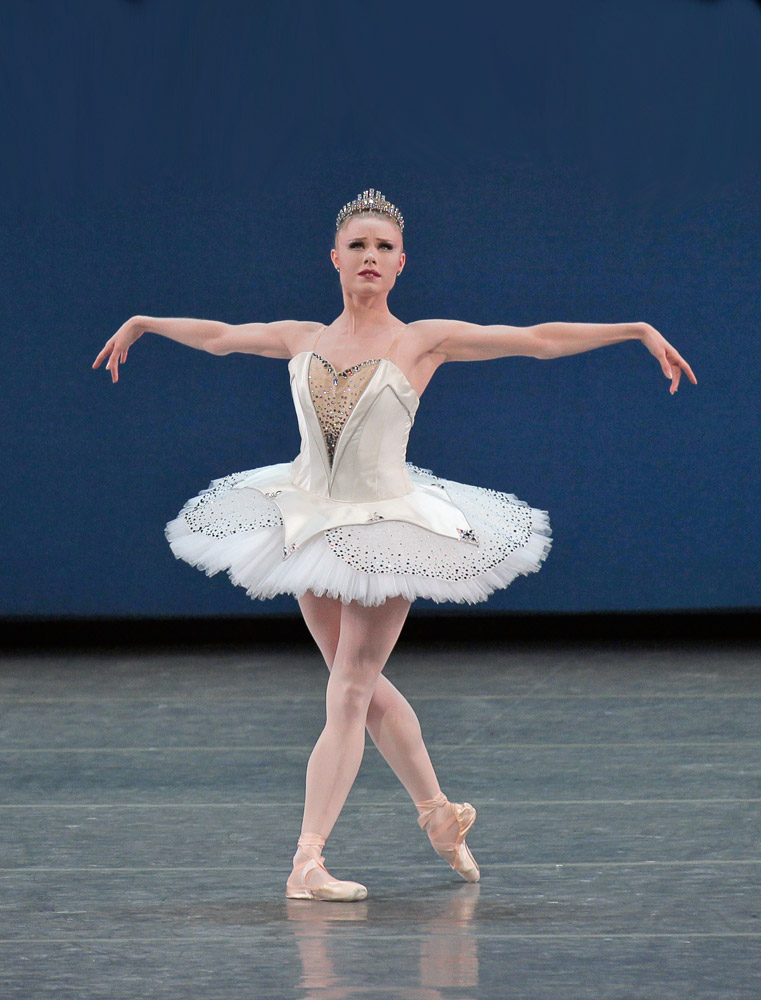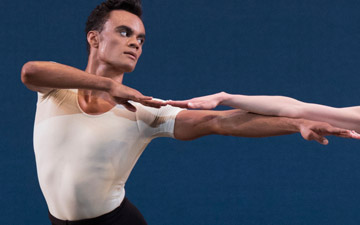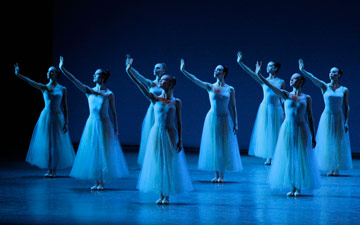
© Paul Kolnik. (Click image for larger version)
New York City Ballet
20th Centry Classics: Serenade, Agon, Symphony in C
Washington, Kennedy Center Opera House
7, 11 (mat) April 21015
www.nycballet.com
www.kennedy-center.org
The first of the two mixed-bill programs of the New York City Ballet’s week-long season at the Kennedy Center in April was entitled 20th Century Classics and comprised three masterpieces of George Balanchine: Serenade, Agon and Symphony in C. Illuminating and groundbreaking in their own unique ways, these works are considered the company’s signature pieces and form the nucleus of “The Essential Balanchine.” On opening night, with exceptional casting in all three ballets, this remarkable program offered the Balanchine experience at its most transcendent, thrilling and unforgettable.
Serenade holds a special place in the NYCB repertory: it marks the company’s very beginning. Balanchine was just 30 years old when he arrived in New York in 1933 at the invitation of Lincoln Kirstein to form a new American ballet company. A year later, the School of American Ballet was up and running, and for its young students Balanchine created his Serenade – his first ballet in the United States.
Named after its music – Tchaikovsky’s “Serenade for Strings in C Major” – Serenade vividly demonstrates some of Balanchine’s most important principles and traits that ultimately would change and shape classical ballet in 20th century America. Not only did he streamline the classical ballet idiom, putting emphasis on pure form and eliminating the excesses and embellishments of the 19th century style, he also redefined and revolutionized the role and place of a ballerina, giving her a bold, innovative movement style together with a sense of empowerment and freedom. From his very first American ballet, Balanchine’s typical ballerina would become a strong and powerful presence, fast and fearless, in charge of her own destiny as opposed to being the fey and frail creature that was the stereotypical female dancer in Romantic and classical ballet.
This novel approach to portraying a woman in ballet is particularly recognizable in Serenade’s opening moment. As the curtain rises, it reveals the 17 young girls arranged in parallels, their heads looking towards the coming light, their hands saluting a new beginning. There is nothing demure and coy in their motionless stance. Their bodies and postures telegraph independence, assertiveness and authority. They are beautiful, graceful and chic, their long blue translucent skirts creating cloud-like shapes around them as they dance about the stage. Over the years, I have watched this ballet performed many times by various companies, including Mariinsky Ballet, Balanchine’s alma mater, and during each performance I saw, the opening tableau never failed to inspire the audience’s awe and applause. This is the power of Balanchine’s genius – his choreographic imagery produces an emotional impact of profound force.
Ashley Bouder, Sterling Hyltin and Teresa Reichlen in the ballet’s leading roles, traditionally demarcated as the Russian Girl, the Waltz Girl, and the Dark Angel, exemplified Serenade’s ideal casting, each of them bringing to their roles the very best of Balanchine’s technique and interpretive style.
I have never seen the third movement of Serenade, Tema Russo, danced with as much sparkling ardor and vitality as it was during this opening night performance. Perpetually astonishing with her superlative technical skills, the exuberant Bouder was her irresistible self: vibrantly dynamic and impetuously playful. She caught the joy and the lively spirit of her part; the energy emanating from her dancing could brighten up the nocturnal sky.
Delicate and willowy, Hyltin brought an air of romantic mystery, tender lyricism and youthful grace to the role of the Waltz Girl. Superbly partnered by the handsome Zachary Catazaro, her windswept whirl in Valse was as thrilling as it was subtle and poetic. Rendering each gesture with elegance and precision, she illuminated the ballet’s finale, Élégie, her transcendent dancing encapsulating the emotional core of this beautiful and poignant Serenade.

© Paul Kolnik. (Click image for larger version)
Technically impeccable, with ravishing physique and endless limbs, Reichlen as the Dark Angel created some of the most unforgettable imagery onstage. Her long leaps and quicksilver turns, her beautiful lines and shapes, and particularly her glorious arabesques, took the audience’s breath away.
Agon (1957) was an apogee of the Balanchine-Stravinsky collaborative partnership and an enduring testament to their shared principles and aesthetics. In this ballet, while the composer was exploring the new sounds and melodic textures, the choreographer introduced a distinctively novel movement vocabulary to match the complex layers of the music’s elaborate contrapuntal patterns. Juxtaposing ancient and modern, Agon’s choreographic architecture not only visually accentuated but enhanced Stravinsky’s edgy, syncopated rhythms, demonstrating time and again Balanchine’s illuminating grasp of the underlying score. Never before did the traditional ballet style look so modern, original, and uniquely American.
Dressed in black-and-white stylized practice costumes, the dancers in Agon (eight women and four men) perform a series of dance episodes – solos, duets, trios and ensembles – each of which evokes a courtly ceremony and a spirited competition at the same time. Steeped in minimalist aesthetics, brisk and sharp, their movements intentionally distort the pure classical line: each step is dislocated, twisted and turned in the most imaginative manner, accentuating the abruptly shifting phrases of the score. Yet at the same time, the choreography as a whole looks graceful, elegant and noble.
The most fascinating moment of Agon is the central pas de deux, famous for its intricate, unconventional partnering. Here, the ballerina embodies an even higher level of female empowerment: she takes charge of her love life. “Like never before, the female dancer participated in explicitly shaping the sexuality of the action, no longer demurely playing the manipulated, submissive respondent,” wrote Charles M. Joseph in his excellent new book, “Stravinsky’s Ballets.”
On opening night, Maria Kowroski was magnificently serene and supremely refined in the ballerina role, wonderfully negotiating the complexity and intricacies of the choreography, her shapely limbs slicing the air with unflustered cool. Her able partner, Amar Ramazar, matched her brilliant technical prowess, dancing with fine articulation and powerful impetus. Anthony Huxley delivered a fine solo in Sarabande, Davin Alberda and Daniel Applebaum brought a nice sense of youthful vigor to Bransle Simple and Rebecca Krohn made a memorable turn in Bransle Gay, a Spanish flavored dance accompanied by clapping and the sounds of castanets.
The French composer Georges Bizet must have been a very happy 17-year-old when he composed his Symphony in C Major. The music feels like sunshine after rain. The colorful melodies, particularly in the symphony’s dazzling finale, burst with cheerful gaiety and joy and beg to be danced. Balanchine was obviously fascinated and attracted by the score’s invigorating rhythms and uplifting spirit; it took him a mere two weeks to create a ballet to Bizet’s radiant music. He called it Le Palais de Cristal. The ballet was made for, and premiered by, the Paris Opéra Ballet in 1947, during Balanchine’s short stint as POB’s guest choreographer. A year later, under the title Symphony in C, the ballet, refurbished and streamlined, was remounted for Ballet Society, the precursor to New York City Ballet. The company has been dancing it ever since.
Symphony in C stands as a triumph of structural and architectural inventiveness in the 20th century classical repertory. The ballet’s ingenious groupings and patterns, its clever hierarchical order (each of the four movements has its own principal couple, an escort of demi-soloists and a supporting ensemble of the corps de ballet) and neat conceptual design will never cease to astonish me. It’s a miracle of a ballet and a real treat for anyone who cares about dance.

© Paul Kolnik. (Click image for larger version)
The opening night cast made Balanchine’s wizardry look even more spectacular. Tiler Peck was thrillingly glamorous and deliciously vivacious in the ballet’s opening Allegro Vivo, setting a tone of utter exhilaration and joyful bliss from the start. Andrew Veyette was her capable and assured partner. The slow second movement, Adagio, brought its own magic and a change of pace. In it, the brilliant Sara Mearns created a world of serenity and gentle passion, dancing with luxurious softness and emotional weight. She looked at ease in her partnership with Jared Angle, and her spacious, floating lifts had a special subtlety and luster. Erica Pereira and Gonzalo Garcia were lively and technically precise in Allegro Vivo, and the effervescent Brittany Pollack and Adrian Danchig-Waring shone in the ballet’s spectacular and uplifting finale, which brought onstage the entire cast in what looked like the most glorious celebration of life through dance.
It was an infinite delight to relive and experience anew the visual wonders and emotional sensations of this program on Saturday afternoon. With such a wealth of talent in the company’s roster, NYCB’s second cast is never “second best.” Sara Mearns as the Waltz Girl totally blew me away with her powerfully expressive and emotionally charged performance. The image of her sacred heroine, poignantly opening her hands to the sky as if releasing her soul to heaven, acquired a special reverential meaning in the ballet’s final moment. Dancing with chilly poise, Megan LeCrone revealed a true mysterious side of the role of the Dark Angel. The excellent Ashly Isaacs made my heart overjoyed with her equally irresistible and delicate performance as the Russian Girl. When Teresa Reichlen enveloped her beautiful long leg around the neck of her partner (Adrian Danchig-Waring) in Agon’s most iconic image, the feminine power in classical ballet never looked more prominent. And I could have watched again and again Ashley Bouder surfing the playful and jolly currents of Symphony in C. The 20th Century Classics program gave us New York City Ballet at its very best.

















You must be logged in to post a comment.